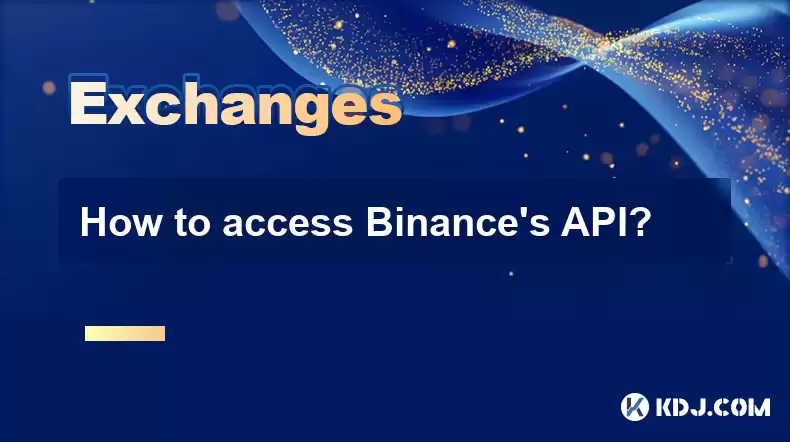-
 bitcoin
bitcoin $99296.318777 USD
-2.82% -
 ethereum
ethereum $3203.465899 USD
-6.84% -
 tether
tether $0.999590 USD
-0.03% -
 xrp
xrp $2.308913 USD
-4.00% -
 bnb
bnb $922.788929 USD
-3.53% -
 solana
solana $144.020807 USD
-5.89% -
 usd-coin
usd-coin $0.999798 USD
0.00% -
 tron
tron $0.291590 USD
-1.12% -
 dogecoin
dogecoin $0.163780 USD
-4.46% -
 cardano
cardano $0.526919 USD
-4.40% -
 hyperliquid
hyperliquid $37.888865 USD
-2.24% -
 bitcoin-cash
bitcoin-cash $510.515457 USD
-1.08% -
 chainlink
chainlink $14.436987 USD
-5.63% -
 stellar
stellar $0.267345 USD
-4.77% -
 unus-sed-leo
unus-sed-leo $9.175222 USD
0.53%
How to access Binance's API?
Binance's API allows users to access real-time data, manage accounts, and execute trades programmatically, offering customization of API key permissions for security.
Apr 16, 2025 at 12:28 am

Introduction to Binance's API
Binance, one of the world's leading cryptocurrency exchanges, offers a powerful API that allows users to access real-time market data, manage their accounts, and execute trades programmatically. Accessing Binance's API can be a valuable tool for traders, developers, and anyone interested in automating their trading strategies. This article will guide you through the process of obtaining and using Binance's API, ensuring you understand every step involved.
Registering for a Binance Account
Before you can access Binance's API, you need to have an account on the platform. If you don't already have one, follow these steps to register:
- Visit the Binance website and click on the 'Register' button.
- Enter your email address and create a strong password. Make sure to use a secure email address that you have access to.
- Complete the verification process by entering the verification code sent to your email.
- Set up two-factor authentication (2FA) for added security. This can be done using an authenticator app like Google Authenticator or Authy.
Once your account is set up and verified, you're ready to move on to the next step.
Creating an API Key
To access Binance's API, you need to create an API key. This key acts as a unique identifier for your account and is required for all API requests. Here's how to create an API key:
- Log in to your Binance account and navigate to the 'API Management' section under the 'Security' tab.
- Click on 'Create New Key' to start the process.
- Enter a label for your API key to help you remember its purpose.
- Enable or disable permissions for your API key. You can choose to allow or restrict access to different functionalities such as trading, withdrawals, and account management.
- Review the API key restrictions and make sure they align with your needs.
- Click on 'Create' to generate your API key.
After creating your API key, you will be prompted to enter a 2FA code to confirm the creation. Once confirmed, you will see your API key and secret key. Make sure to save both keys in a secure location, as you will not be able to view the secret key again after closing the window.
Understanding API Key Permissions
Binance's API allows you to customize the permissions of your API key, ensuring that you can control what actions can be performed using your key. Here are the main types of permissions you can enable or disable:
- Enable Trading: This permission allows the API key to execute trades on your behalf.
- Enable Withdrawals: This permission allows the API key to withdraw funds from your account.
- Enable Spot & Margin Trading: This permission allows the API key to access both spot and margin trading functionalities.
- Enable Futures: This permission allows the API key to access futures trading functionalities.
It's important to carefully consider which permissions you need and to only enable the ones necessary for your use case. Enabling unnecessary permissions can increase the risk of unauthorized access to your account.
Using the Binance API
Once you have your API key and secret key, you can start using the Binance API. Here's a basic guide on how to get started:
Choose a programming language: Binance's API supports multiple programming languages, including Python, JavaScript, and Java. Choose the language that you are most comfortable with.
Install the Binance API library: Depending on your chosen language, you will need to install the appropriate Binance API library. For example, if you are using Python, you can install the
python-binancelibrary using pip:pip install python-binanceSet up your API credentials: Use your API key and secret key to authenticate your API requests. Here's an example of how to set up your credentials in Python:
from binance.client import Clientapi_key = 'your_api_key'api_secret = 'your_api_secret'
client = Client(api_key, api_secret)
Make API requests: Once your credentials are set up, you can start making API requests. Here's an example of how to retrieve the current price of Bitcoin (BTC) in USDT:
btc_price = client.get_symbol_ticker(symbol='BTCUSDT')print(btc_price['price'])
Securing Your API Key
Securing your API key is crucial to prevent unauthorized access to your Binance account. Here are some best practices for securing your API key:
- Use a secure storage method: Store your API key and secret key in a secure location, such as an encrypted file or a secure password manager.
- Limit API key permissions: Only enable the permissions that are necessary for your use case. Avoid enabling permissions that you don't need, such as withdrawals.
- Use IP restrictions: Binance allows you to restrict API key access to specific IP addresses. This can help prevent unauthorized access from unknown locations.
- Monitor API key usage: Regularly check the API key usage logs in your Binance account to detect any suspicious activity.
Troubleshooting Common Issues
When using Binance's API, you may encounter some common issues. Here are some troubleshooting tips to help you resolve them:
- Invalid API Key: If you receive an error message indicating that your API key is invalid, double-check that you have entered the correct API key and secret key. Make sure you have not accidentally shared your secret key with anyone.
- Rate Limit Exceeded: Binance's API has rate limits in place to prevent abuse. If you exceed these limits, you will receive a rate limit error. To resolve this, you can either wait for the rate limit to reset or adjust your API requests to stay within the limits.
- Connection Issues: If you are having trouble connecting to the Binance API, check your internet connection and ensure that you are using the correct API endpoint. You can also try using a different API library or programming language to see if the issue persists.
Frequently Asked Questions
Q: Can I use the same API key for multiple applications?A: Yes, you can use the same API key for multiple applications. However, it's important to consider the security implications of sharing your API key across different applications. If one application is compromised, it could potentially affect all other applications using the same API key. It's recommended to create separate API keys for each application to minimize this risk.
Q: How often can I make API requests to Binance?A: Binance has rate limits in place to prevent abuse of their API. The exact rate limits depend on the type of request and the endpoint you are using. For example, the public endpoints for market data have higher rate limits compared to the private endpoints for account management and trading. You can find detailed information on Binance's rate limits in their API documentation.
Q: What should I do if my API key is compromised?A: If you suspect that your API key has been compromised, take immediate action to secure your account. First, revoke the compromised API key by navigating to the 'API Management' section in your Binance account and deleting the key. Then, create a new API key with the necessary permissions. Additionally, review your account activity and report any suspicious transactions to Binance's customer support.
Q: Can I use Binance's API for automated trading strategies?A: Yes, Binance's API is designed to support automated trading strategies. You can use the API to execute trades, retrieve market data, and manage your account programmatically. However, it's important to thoroughly test your trading strategies in a safe environment before deploying them on the live market. Additionally, ensure that your API key permissions are set correctly to avoid unintended actions.
Disclaimer:info@kdj.com
The information provided is not trading advice. kdj.com does not assume any responsibility for any investments made based on the information provided in this article. Cryptocurrencies are highly volatile and it is highly recommended that you invest with caution after thorough research!
If you believe that the content used on this website infringes your copyright, please contact us immediately (info@kdj.com) and we will delete it promptly.
- Crypto Carnage: Navigating Selling and Liquidations in a Wild Market
- 2025-11-14 16:50:01
- Mohammed Siraj's First Spell Woes: An India Teammate's Critique
- 2025-11-14 14:40:02
- BTC, ETH, and Altcoin Picks: Navigating the Crypto Landscape
- 2025-11-14 14:50:01
- Coin Toss Tales: Temba Bavuma's Wager and India vs. SA Showdown
- 2025-11-14 12:50:01
- Shubman Gill, WTC Final, and the Coin Toss: A New Yorker's Take
- 2025-11-14 15:05:01
- Aerodrome Takes Flight: Unifying Ethereum DeFi Liquidity Across Chains
- 2025-11-14 15:10:02
Related knowledge

The Ultimate Guide to Bybit's Trading Competitions and Events
Nov 14,2025 at 01:39am
The Ultimate Guide to Bybit's Trading Competitions and Events Bybit has established itself as a leading cryptocurrency derivatives exchange, not only ...

Bybit Mobile App: A Comprehensive Tutorial for Trading on the Go
Nov 14,2025 at 08:19am
Getting Started with the Bybit Mobile App1. Download the Bybit app from the Apple App Store or Google Play Store, ensuring you are installing the offi...

A Complete Guide to Bybit's Proof of Reserves (PoR) System
Nov 14,2025 at 03:40am
Understanding Bybit's Proof of Reserves (PoR) Framework1. Bybit’s Proof of Reserves (PoR) system is a transparency initiative designed to verify that ...

The Professional Trader's Guide to Risk Management on Bybit
Nov 15,2025 at 12:00am
Understanding Risk Exposure in Derivatives Trading1. Derivatives trading on platforms like Bybit exposes traders to amplified risk due to leverage. Wh...

Bybit Staking Explained: A Complete Guide to Earning Rewards
Nov 14,2025 at 08:40pm
What Is Staking on Bybit?1. Staking on Bybit allows users to lock up their cryptocurrency holdings in exchange for rewards over time. This process sup...

Advanced Charting Techniques on Bybit: A Technical Analysis Guide
Nov 14,2025 at 04:20am
Mastering Candlestick Patterns for Precision Entries1. Understanding candlestick formations is essential when trading on Bybit, where volatility can s...

The Ultimate Guide to Bybit's Trading Competitions and Events
Nov 14,2025 at 01:39am
The Ultimate Guide to Bybit's Trading Competitions and Events Bybit has established itself as a leading cryptocurrency derivatives exchange, not only ...

Bybit Mobile App: A Comprehensive Tutorial for Trading on the Go
Nov 14,2025 at 08:19am
Getting Started with the Bybit Mobile App1. Download the Bybit app from the Apple App Store or Google Play Store, ensuring you are installing the offi...

A Complete Guide to Bybit's Proof of Reserves (PoR) System
Nov 14,2025 at 03:40am
Understanding Bybit's Proof of Reserves (PoR) Framework1. Bybit’s Proof of Reserves (PoR) system is a transparency initiative designed to verify that ...

The Professional Trader's Guide to Risk Management on Bybit
Nov 15,2025 at 12:00am
Understanding Risk Exposure in Derivatives Trading1. Derivatives trading on platforms like Bybit exposes traders to amplified risk due to leverage. Wh...

Bybit Staking Explained: A Complete Guide to Earning Rewards
Nov 14,2025 at 08:40pm
What Is Staking on Bybit?1. Staking on Bybit allows users to lock up their cryptocurrency holdings in exchange for rewards over time. This process sup...

Advanced Charting Techniques on Bybit: A Technical Analysis Guide
Nov 14,2025 at 04:20am
Mastering Candlestick Patterns for Precision Entries1. Understanding candlestick formations is essential when trading on Bybit, where volatility can s...
See all articles










































































